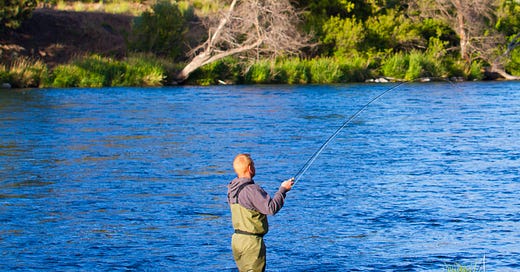The Skwala hatch on Oregon rivers generally occurs from late February through May, with peak activity often in March and April, depending on the river and weather conditions. Water temperatures between 40–47°F, with adults hatching around 43°F, trigger the hatch. Lower-elevation streams see earlier hatches, while colder, higher-elevation rivers may delay until late spring. Variable spring weather, including cold snaps or early runoff, can shift timing year to year.
Best Oregon Rivers for Skwala Hatch
While the Skwala hatch is less widespread in Oregon compared to rivers like the Yakima in Washington or Bitterroot in Montana, several Oregon rivers offer notable Skwala fishing:
Deschutes River
Hatch Timing: Late March to early May, peaking in April.
Why It’s Great: The Deschutes, particularly the lower 100 miles from Pelton Dam to Maupin, is a premier trout fishery with strong Skwala hatches. The hatch precedes the famous salmonfly hatch, offering excellent dry-fly fishing for native redside rainbow trout.
Notes: Look for Skwalas in riffles and along banks during warmer afternoons. The river’s accessibility and consistent flows make it ideal
.
Owyhee River
Hatch Timing: March 1 to April 15.
Why It’s Great: This remote eastern Oregon river is one of the state’s best brown trout fisheries. The Skwala hatch provides exciting dry-fly opportunities in the canyon section below Owyhee Reservoir, where stable water temperatures support robust insect life.
Notes: Check rocks and willows for Skwala shucks to confirm the hatch. The Owyhee’s solitude and big fish make it a hidden gem.
North Umpqua River
Hatch Timing: Late February to April.
Why It’s Great: Known for its scenic beauty and wild trout, the North Umpqua has a decent Skwala hatch that draws anglers for early-season dry-fly action. It’s less intense than the Deschutes but rewarding for skilled anglers.
Notes: Focus on warmer days and check shallow riffles for nymphs. The river’s technical fishing suits experienced fly anglers.
Rogue River
Hatch Timing: March to early May.
Why It’s Great: The Rogue supports a variety of trout and sees a minor but productive Skwala hatch, especially in the upper sections. It’s also known for salmonfly hatches, but Skwalas kick off the season.
Notes: Target slower pools and bankside structure. The Rogue’s accessibility and diverse fishery make it a solid choice.
Tips for Fishing the Skwala Hatch
Water Temperature: Monitor river gauges for 40–47°F highs, with 43°F ideal for adult hatches.
Scouting: Check banks, rocks, and willows for Skwala nymphs or shucks to confirm activity.
Timing: Fish during the warmest part of the day, typically midday to late afternoon, when Skwalas are most active.
Flies: Use size 8–10 Skwala patterns (Tan or Golden Chubby Chernobyl or Long Tail Skwala) for dries and stonefly nymphs for subsurface fishing.
Conditions: Spring weather can be volatile. Avoid high, muddy water from early runoff, and be prepared for snow or rain.
Why These Rivers Stand Out
The Deschutes and Owyhee are the top picks due to their strong Skwala hatches, robust trout populations, and reliable dry-fly opportunities. The North Umpqua and Rogue are excellent alternatives for anglers seeking scenic settings and less pressure, though their Skwala hatches are less prolific. Always check local river conditions and regulations, as some sections (e.g., Deschutes near Warm Springs) may have seasonal closures.




